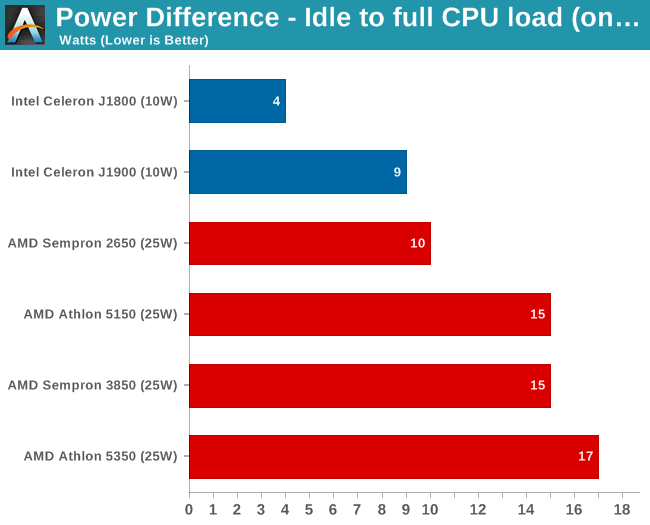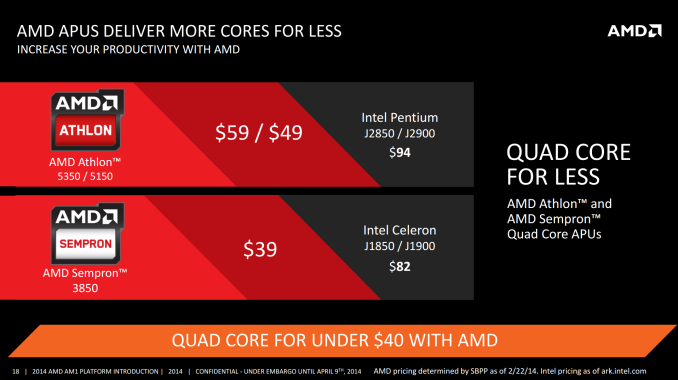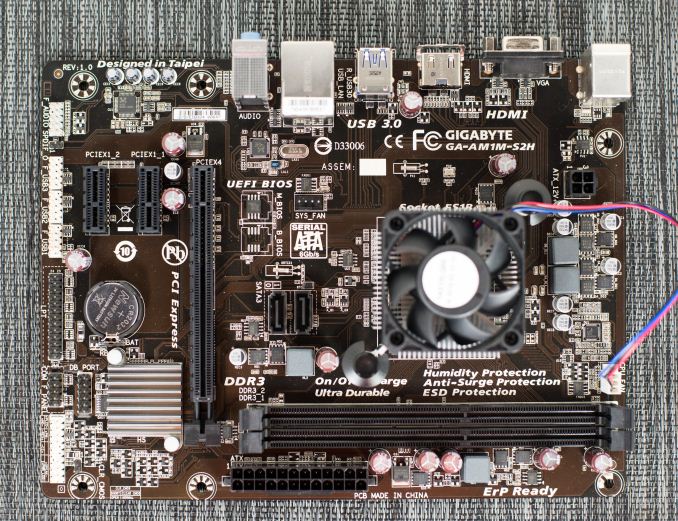AMD AM1 Kabini Part 2: Athlon 5350/5150 and Sempron 3850/2650 Tested
by Ian Cutress on May 29, 2014 2:00 PM ESTThe Competition
Because AMD is the first x86 CPU manufacturer to move their tablet focused processors into the socketed market along with low-cost motherboards, Intel has no direct comparative product. We have to look to their Bay Trail-D SoC range which loses that upgradable functionality. Competition between AMD and Intel on this front is a tit-for-tat operation, with each company focusing on their different strengths. AMD’s integrated IGP aims to be more powerful than the equivalent Intel along with support for DDR3-1600 memory, as well as cheaper overall, however Intel can boast dual channel memory and a lower power output.
With all these differences between Kabini and Bay Trail, including price, power and cores/threads, it is hard to find Intel parts that accurately match each other. AMD has put the following in front of reviewers to provide a guide:
AMD consider the Athlon 5350/5150 parts (quad core, 2.05 GHz and 1.6 GHz) in line with the Intel Pentium J2850/J2900, and the Sempron 3850 with the J1850/J1900. For this Part 2 we were able to obtain full Celeron J1800 (dual core) and Celeron J1900 (quad core) Bay Trail-D parts for testing. Even though AMD puts the Athlon 5350 in the path of the J2900, the J2900 is primarily an OEM solution used by Acer. A single J2900 motherboard appeared on Newegg a week after we had packed up testing.
In fact, I think the 5350 vs the J1900 is a better fit:
| AMD Athlon 5350 vs. Intel Celeron J1900 | ||||
| Athlon 5350 | Celeron J1900 | |||
| CPU Architecture | Jaguar | Silvermont | ||
| CPU Cores | 4 | 4 | ||
| CPU Frequency | 2.05 GHz | 2.0 GHz / 2.4 GHz Turbo | ||
| GPU Cores | 128 SPs | 6 EUs | ||
| GPU Frequency | 600 MHz | 688 MHz | ||
| Memory Channels | Single | Dual | ||
| Memory Frequency | 1600 MHz | 1333 MHz | ||
| L2 Cache | 2 MB | 2 MB | ||
| TDP | 25 W | 10 W | ||
| Price | $59 | $82 | ||
Also we can now directly compare pricing. Take for example the two of the motherboards we had for this review, one J1900 and the other AM1 while equipping the system with an Athlon 5350:
GIGABYTE J1900N-D3V: $87 (Newegg)
GIGABYTE AM1M-S2H: $35 (Newegg)
AMD Athlon 5350: $65 (Newegg)
Totaling up the AMD components gives $100 vs $87 from Newegg, or £65 vs. £66 on Amazon UK, on the extreme high end of a Kabini AM1 setup. Pricing is also influenced slightly by quoting the boxed version of the APU, rather than the OEM pricing that AMD likes to quote.
Our test setup is a follows:
| Test Setup | |
| CPU | AMD Athlon 5350, Quad Core, 2.05 GHz |
| AMD Athlon 5150, Quad Core, 1.60 GHz | |
| AMD Sempron 3850, Quad Core, 1.30 GHz | |
| AMD Sempron 2650, Dual Core, 1.45 GHz | |
| Motherboard | GIGABYTE AM1M-S2H |
| Memory | 2x4GB DDR3-1600 9-10-10 |
| SSD | OCZ Vertex 3 |
| Power Supply | OCZ 1250W ZX Series |
| Graphics | Integrated |
| Graphics Drivers | 14.3 Beta |
Note that for our benchmark results we are also taking data from previous reviews done at AnandTech, including some of the higher powered mainstream systems. Over time we have added benchmarks (such as SYSmark 2014) which are lacking some of the mid-range data.
Power Consumption: Idle to 100% CPU Load (on IGP)

Because of the difference in TDP, the AMD APUs here use more energy, although all four comfortably use less than the 25W TDP. The dual core especially only registered a 10W difference from idle to a full CPU load.













87 Comments
View All Comments
serpretetsky - Thursday, May 29, 2014 - link
I'm not sure I understand the power chart on page 2. Is the title correct? Power difference? So the numbers we are seeing are power differentials between idle and load and not absolute values?casteve - Friday, May 30, 2014 - link
Ian uses a 1250W PSU in this setup. So, absolute value is pretty meaningless when your system idles down in the low efficiency (and high slope) part of the power supply's curve. The delta power part at least provides an idea of what's going on.jospoortvliet - Sunday, June 1, 2014 - link
Yet idle power is quite important - cpu's are idle most of the time...coburn_c - Thursday, May 29, 2014 - link
There's your future of AMD. Scaling up Jaguar will fix their code/module problems and improve their perf/watt. There is certainly no future in their big cores.rootheday3 - Thursday, May 29, 2014 - link
Ivy Bridge gt1 was 6 eus; bay trail is 4 eus.jvp - Friday, May 30, 2014 - link
What is missing in this review is that some Intel processors have stripped down instruction sets. Like the Celeron J1900 with which the Athlon 5350 is compared as direct competitor.I'm also missing tests about performance when using virtual machines, and hardware accelerated encryption. These are area's that are becoming more and more important for systems.
R3MF - Friday, May 30, 2014 - link
this is lovely, thanks, but how long before we get beema in socket AM1?R3MF - Friday, May 30, 2014 - link
in addition, do i understand correctly that:kabini is 28nm TSMC, whereas
beema is 28nm GF
plonk420 - Friday, May 30, 2014 - link
thank you thank you THANK YOU for including i3-4300 series on the dGPU page! i've been wondering how they stand up to gaming on a budget as i've helped do 2 builds in the last couple months for the first time in years!Icehawk - Friday, May 30, 2014 - link
I'm with prior posters - testing these low end machines with current games is all well and good but also unlikely to happen in real life. Can these handle games I'd be more likely to want to play on a low power device like TF2 or Diablo 3? NO CLUE.